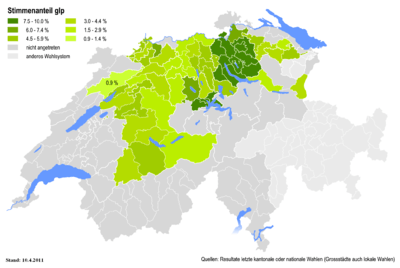Green Liberal Party of Switzerland
The Green Liberal Party of Switzerland (German: Grünliberale Partei der Schweiz, glp; French: Parti vert'libéral, pvl), abbreviated to glp, is a centrist green-liberal political party in Switzerland. Founded in 2007, the party holds sixteen seats in the Federal Assembly as of the October 2019 election.
Green Liberal Party of Switzerland | |
|---|---|
 | |
| German name | Grünliberale Partei (glp) |
| French name | Parti vert'libéral (pvl) |
| Italian name | Partito Verde-Liberale (pvl) |
| Romansh name | Partida Verda-Liberala (pvl) |
| President | Jürg Grossen |
| Members of the Federal Council | None |
| Founded | 19 July 2007 |
| Split from | Green Party of Switzerland |
| Headquarters | Monbijoustrasse 30 3011 Berne |
| Membership (2019) | 5,000[1] |
| Ideology | Green liberalism[2] Social liberalism Economic liberalism Pro-Europeanism |
| Political position | Centre[3] to centre-right[4] |
| European affiliation | Alliance of Liberals and Democrats for Europe Party[5] |
| Colours | Light green Light blue |
| National Council | 16 / 200 |
| Council of States | 0 / 46 |
| Cantonal legislatures | 99 / 2,609 |
| Website | |
| www | |
Swiss Federal Council Federal Chancellor Federal Assembly Council of States (members) National Council (members) Voting | |
The party was formed on 19 July 2007 by four cantonal branches of the Green Party. Contesting the election in October 2007 in St. Gallen and Zurich, the party won three seats in the National Council. A month later, the party won a seat in the Council of States, with Verena Diener representing Zurich. The party has since expanded across Switzerland, and holds seats in thirteen cantonal legislatures in German-speaking Switzerland and the Romandy. The party reached 5.4% at the 2011 federal election,[6] increasing the number of Members of the National Council from 3 to 12, but suffered a setback in 2015 retreating to 7 seats with 4,6% of the national vote.[7]
The Green Liberals are a party of the political centre,[3] as opposed to the left Green Party. They seek to combine liberalism on civil liberties and moderate economic liberalism with environmental sustainability.[8] The party has an autonomous parliamentary group in the Federal Assembly of Switzerland since the 2011 federal election.[9]
History
The party was founded on 19 July 2007 by four cantonal parties of the same name that had seceded from the Green Party.[10] These branches were in Basel-Landschaft, Bern, St. Gallen, and Zurich.
In the 2007 election to the National Council on 22 October 2007, the party ran in Zurich and St. Gallen.[11] Despite being limited to only two cantons, the party won 1.4% of the popular vote nationwide and 3 out of 200 seats. In Zurich, they won 7% of the vote.[11] One of these three had been a National Councillor for the Green Party in the previous Parliament.
A month later, it won a seat in the Council of States, with Verena Diener representing Zurich. Along with the first appearance of the Green Party, this was the first time a minor party had won representation in the Council of States since 1995.[12] When the Federal Assembly convened, the glp joined the Christian Democrats/EPP/glp Group,[11] making it the second-largest group, behind the Swiss People's Party.[13] In 2010 the party got an additional seat in the Council of States with Markus Stadler from Uri.
There are now eighteen cantonal parties: Zurich, St. Gallen, Basel-Country, Bern, Zug, Thurgau, Basel-Stadt, Graubünden, Lucerne, Aargau, Solothurn, Fribourg, Vaud, Geneva, Neuchâtel, Glarus, Schwyz and Schaffhausen.

Elected representatives
Council of States
None since the 2015 election.
National Council
Since the 2015 election:
- Martin Bäumle
- Kathrin Bertschy
- Isabelle Chevalley
- Beat Flach
- Jürg Grossen
- Tiana Angelina Moser
- Thomas Weibel
Since 2019
- Daniel Frei
References
- The Swiss Confederation — A Brief Guide. Federal Chancellery. 2015. p. 20. Archived from the original (PDF) on 20 December 2016. Retrieved 14 December 2016.
- Switzerland Parliament Guide: Strategic Information, Regulations, Developments. 1 (2019 ed.). International Business Publications, USA. p. 63. ISBN 1-4387-4694-6.
- Federal Chancellery, Communication Support (2016). The Swiss Confederation – a brief guide. Switzerland: Swiss Confederation. p. 18. Archived from the original (PDF) on 20 December 2016. Retrieved 11 December 2016.
- Church, Clive H. (2007). "Europe and the Swiss Parliamentary Election of 21 October 2007" (PDF). Election Briefing. 39. European Parties Elections and Referendums Network. Archived from the original (PDF) on 26 March 2010. Cite journal requires
|journal=(help) - "ALDE Party Council meets in Zürich". ALDE. 28 June 2019. Retrieved 28 June 2019.
- Eckdaten Nationalrat 2011 / 2007 (in German), Swiss Parliament, archived from the original on 27 January 2012
- Bundesamt für Statistik. "Nationalratswahlen: Übersicht Schweiz". Archived from the original on 20 October 2015. Retrieved 19 October 2015.
- Green Liberal Party. "What we stand for". Retrieved 30 August 2016.
- "Parliamentary groups of the 49th legislative period 2011 - 2015". Federal Assembly of Switzerland. Archived from the original on 29 April 2014. Retrieved 24 January 2014.
- Milic, Thomas (December 2008). "Switzerland". European Journal of Political Research. 47 (7–8): 1148–55. doi:10.1111/j.1475-6765.2008.00812.x.
- Dardanelli, Paolo (December 2008). "The Swiss federal elections of 2007". Electoral Studies. 27 (4): 748–51. doi:10.1016/j.electstud.2008.04.010.
- "Parteipolitische Zusammensetzung des Ständerates nach den Wahlen". Federal Assembly of Switzerland. Archived from the original on 5 May 2010. Retrieved 2 April 2010.
- "Parliamentary groups of the 48th legislative period 2007-2011". Federal Assembly of Switzerland. Archived from the original on 24 March 2010. Retrieved 2 April 2010.